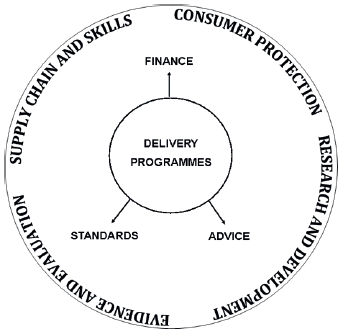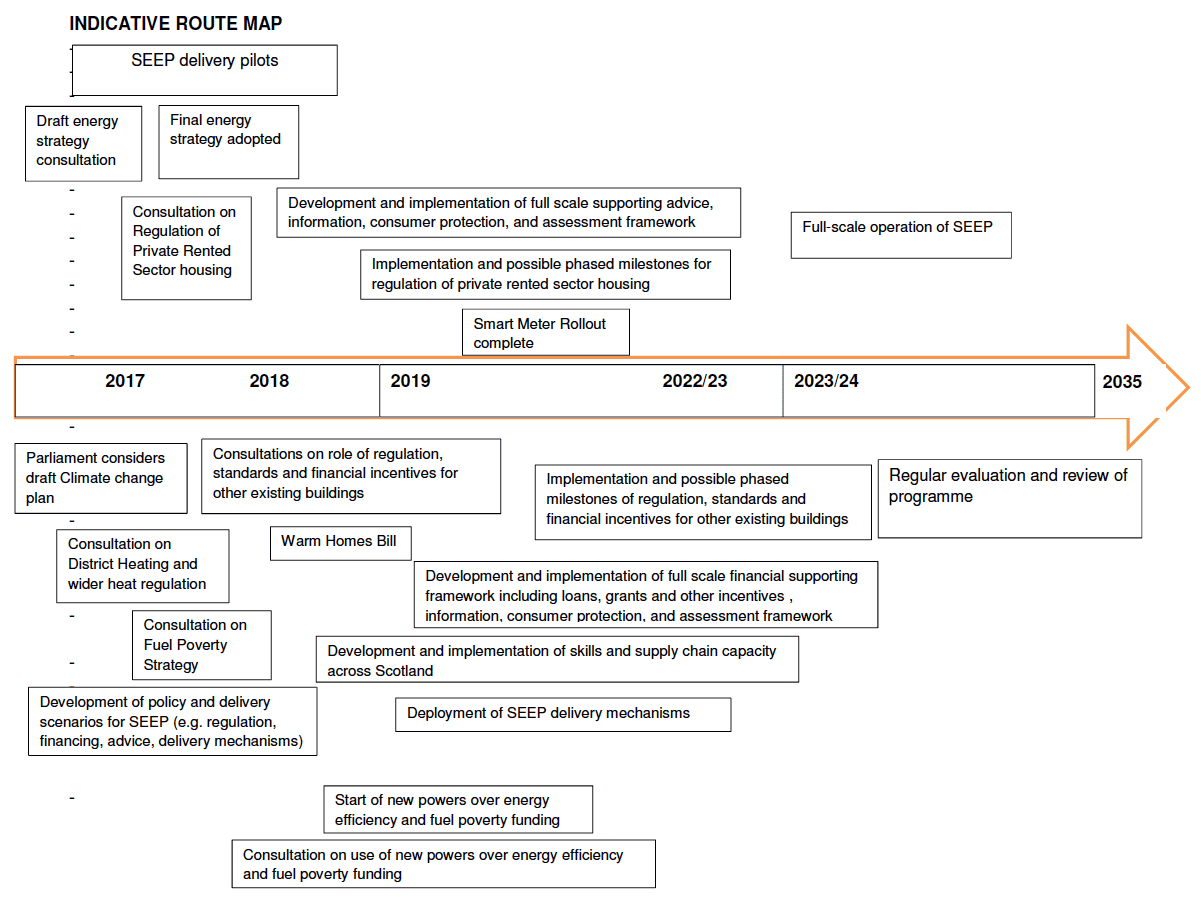Scottish energy strategy: Scotland's Energy Efficiency Programme (SEEP)
The 15 to 20 year programme is the cornerstone of Scottish government's approach to energy efficiency, a National Infrastructure Priority.
1. Introduction
1. The Scottish Government's world-leading climate change targets require emissions from across Scotland to be reduced by 42% by 2020 and at least 80% by 2050. The recently published draft Climate Change Plan outlines the steps we will take to reduce emissions across the economy, including the residential and services sectors which will see their emissions reduced by 75% and 98%, respectively, by 2032 on 2014 levels.
2. Achieving these targets will mean that to be fit for the future Scotland's homes, commercial properties and the public sector estate will need to be near zero carbon by the middle of this century. Delivering this will be very challenging and must be done in a way that is both socially and economically sustainable. Improving the energy efficiency of Scotland's buildings, decarbonising their heat supply and tackling fuel poverty will have many positive benefits including supporting jobs nationwide, enhancing businesses' competitiveness, as well as improving health and early years outcomes.
3. Scottish Ministers announced in June 2015 that they would take long-term action to reduce the energy demand of, and decarbonise the heat supply to, our residential, services and industrial sectors, and designated energy efficiency as a national infrastructure priority. [1]
4. The cornerstone of this will be Scotland's Energy Efficiency Programme ( SEEP) which is under development and will be rolled out from 2018. This ambitious new programme will contribute to achieving our climate change targets, whilst continuing to help tackle fuel poverty and ensuring Scotland is a good place to do business. SEEP will be a coordinated programme to improve the energy efficiency of homes and buildings in the commercial, public and industrial sectors and to decarbonise their heat supply, with an initial estimated overall investment in excess of £10 billion, the final figure will be determined by decisions taken on the future decarbonisation of the heat supply.
5. The Programme for Government 2016-17 (PfG) commits to investing more than £0.5 billion in energy efficiency and combating fuel poverty through SEEP over the next four years, setting out a clear commitment to develop this programme with substantial annual public funding. Multi-year funds will give our delivery partners the certainty they need to deliver ambitious energy efficiency projects. SEEP will be an unprecedented, large-scale, long-term programme operating for up to 20 years across all parts of Scotland. It will be a coordinated programme to make our homes warmer and places of work more comfortable; promote more affordable energy for consumers; help to tackle fuel poverty; improve competitiveness of the Scottish economy; create substantial market and supply chain opportunities; and contribute to meeting our climate change targets.
SEEP - Initial programme development
6. The scale and scope of SEEP is such that a phased approach over a number of years is envisaged to enable the successful development of all elements of the Programme, including incentives, standards and regulations, supply chain, advice and information, consumer protection and monitoring and evaluation, as shown in the diagram below. This phased approach will involve significant public consultation and engagement with delivery partners across Scotland, as well as piloting new approaches to inform the Programme, enabling households, landlords and businesses to input into SEEP before it becomes fully operational.
Once fully operational SEEP will be a whole system approach to delivering energy efficiency improvements and the provision of low carbon heat. A framework of standards, advice and funding will help create long-term consistency and confidence for consumers and industry. The programme will also help develop supporting skills and supply chains across Scotland with appropriate protections for consumers.

7. During the initial phases of the Programme we are focusing on delivering existing programmes more effectively and developing new pilot schemes to test delivery mechanisms for domestic and non-domestic buildings.
8. In September 2016, the Scottish Government announced that £9.1 million of funding would be made available to local authorities for SEEP pilot projects in 2016-17. [2] These pilots are delivering real measures on the ground to test innovative and coordinated approaches to energy demand reduction in domestic and non-domestic buildings. The Programme for Government commits the Scottish Government to further funding being made available next year for pilots, and we are working with local authorities with a view to issuing a second call for pilots early in 2017.
9. The Programme for Government also commits the Scottish Government to bring forward consultations to inform the development of SEEP, including:
- the regulation of private rented sector housing to increase efficiency standards;
- heat regulations commensurate with the scale of the heat market; and
- phased regulation of other existing buildings to bring them up to higher energy efficiency standards as well as an exploration of financial incentives.
10. A short-life working group on heat regulation was established by the Minister for Business, Innovation & Energy to advise on regulatory scenarios. The related consultation on heat regulation has been published as a separate annex within the draft Energy Strategy. Our intention is that the consultation on regulation of private rented sector housing will be published in February and will also give further information on when consultation will take place on the role of incentives and minimum standards for owner-occupied housing.
11. As noted above, we will also consult on a new Fuel Poverty Strategy and statutory target later in 2017.
Development of a new Fuel Poverty Strategy
12. As well as supporting a low carbon energy system, SEEP is instrumental in tackling fuel poverty and, in developing the Programme, we will take account of the recommendations of the Fuel Poverty Strategic Working Group and the Rural Fuel Poverty Task Force. The Strategic Working Group identified four key drivers of fuel poverty, three of which - energy costs, energy performance and how energy is used in the home - are directly relevant to SEEP, the fourth driver being household income. Scottish Ministers will formally respond to the two reports in early 2017, but have already accepted the recommendation to review the current definition of fuel poverty due to concerns that it is too broad and impedes targeting those most in need. Ministers have also committed to setting a new statutory fuel poverty target and long-term strategy, and to introduce Warm Homes legislation in this Parliament to deliver these.
13. The Scotland Act 2016 devolves additional powers to Scottish Ministers over domestic energy efficiency and fuel poverty, giving further scope to design schemes that suit Scotland's circumstances. We are giving early consideration to how we can use these new flexibilities and aim to consult on proposals in 2017.
Programme timescales
14. The Programme is characterised by three key phases:
- a design phase - including the setting of formal targets for the Programme through the Climate Change Plan and Energy Strategy - which is expected to run through to early 2018;
- a development phase in which the key elements of the Programme are developed and deployed over time to create the overall programme structure which is expected to run through until circa 2021/22; and
- full deployment of the Programme which would be subject to regular review, evaluation and refinement.

Pre-consultation scoping work for SEEP
15. The Scottish Government has already undertaken a period of pre-consultation scoping work on scenarios for the whole programme with internal and external stakeholders in Autumn 2016. These discussions considered the following elements which will form the constituent parts of the Programme:
- the effectiveness of governance and accountability;
- the role of regulation, standards and financial incentives;
- the level of future financial support necessary to help longer-term planning;
- the provision of advice, information and consumer protection;
- the establishment and sustainability of local supply chains and trusted delivery agents; and
- the nature of Programme delivery.
16. The Scottish Government is now formally consulting on these different options for programme and policy design, as set out in the sections on the following pages, and will use the responses gathered in this consultation to inform policy decisions on the overall design and operation of SEEP.
Contact
Email: SEEP Consultation Mailbox
There is a problem
Thanks for your feedback